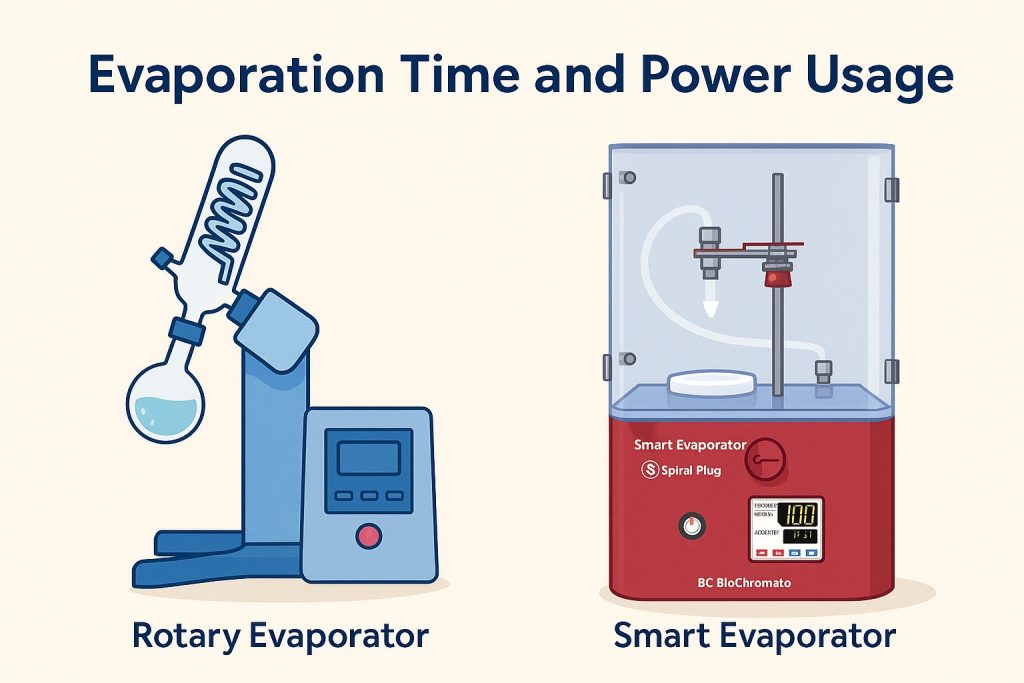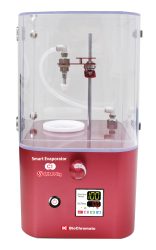Rotary Evaporator vs. Energy-Efficient Alternatives: How to Cut Evaporation Time and Power Usage

Many researchers continue to rely on rotary evaporators without questioning their energy usage or time efficiency—especially when dealing with high-boiling solvents like DMSO or DMF.
But in a time when energy costs are rising and sustainability is becoming a priority, it’s worth asking: Is there a smarter way to evaporate?
According to S-Lab’s Energy Consumption of University Laboratories report (2011), ventilation and HVAC systems make up 50–60% of total energy use in chemistry labs at UK universities such as Cambridge. Equipment and small power devices—including evaporators and chillers—account for an additional 17–19%, with peak costs reaching as high as 31% depending on setup.
Smarter evaporation tools, like Smart Evaporator™, can reduce both evaporation time and energy use—helping labs align with environmental targets while maintaining research performance.
Table of Contents
1. What Makes Rotary Evaporators a Lab Staple?
2. Are You Overlooking Hidden Energy Costs?
3. When Is It Worth Considering a Change?
4. Spotlight on Smart Evaporator™ – Energy & Time Advantages
5. Balancing Performance and Sustainability in Lab Equipment
6. Summary – One Size Doesn’t Fit All
1. What Makes Rotary Evaporators a Lab Staple?
Rotary evaporators have long been a workhorse in chemistry and biology labs. Their strength lies in efficiently removing low-boiling solvents—like ethanol and acetone—in large volumes. With a rotating flask, heated water bath, and vacuum pressure, they accelerate evaporation while minimizing thermal degradation of sensitive compounds.
They are widely appreciated for their:
⚙️ Efficient bulk processing
Quickly evaporates large volumes of low-boiling solvents to save time.
🔄 Gentle, uniform heating
Rotating flask prevents overheating, protecting sensitive samples.
🧪 High solvent recovery
Vacuum and condenser systems efficiently recover solvents, reducing waste and costs.
However, as lab operations evolve, so do expectations around sustainability and efficiency. Rotary evaporators require a substantial power input from heated baths, vacuum pumps, and, in some cases, chillers. In labs where energy savings and operational flexibility are becoming performance criteria, it’s worth asking: Is your rotary evaporator still the best tool for every task?
🔽 Quick Comparison: Rotary Evaporator Use Case Snapshot
| Use Case | Rotary Evaporator ✅ | Alternatives (e.g. Smart Evaporator™) ✅ |
|---|---|---|
| Bulk low-boiling solvents | ✔️ Highly efficient | ✖️ Less efficient |
| High-boiling solvents (DMSO) | ✖️ Less efficient and slower | ✔️ Efficient and faster |
| Multi-sample processing | ✖️ Manual setup required for each flask | ✔️ Models available for up to 10 samples simultaneously |
| Energy-efficient operation | ✖️ Power-intensive | ✔️ Lower overall energy use |
The terms “efficient” and “energy use” in this table reflect average performance across key criteria such as evaporation time per sample, power consumption per device, and operator workload.
2. Are You Overlooking Hidden Energy Costs?
While rotary evaporators perform reliably, they often go unnoticed as a source of ongoing energy consumption. A typical setup includes:
| Component | Power Range (Watts) | Notes |
|---|---|---|
| Water Bath | 500–1000 W | Often left on between uses |
| Vacuum Pump | 100–500 W | Runs continuously |
| Chiller | 600–900 W | Optional but common |
A standard rotavap system—depending on chiller presence, bath temperature, and pump type—may consume 1.5–3.0 kWh per day. Over weeks or months, this adds up significantly—especially in labs running multiple units.
Leaving systems idle without turning them off can lead to unnecessary energy waste. For labs aiming to reduce their carbon footprint or meet internal sustainability benchmarks, identifying and addressing this hidden consumption is essential.
Ready to Reduce Energy Use Without Compromising Research?
3. When Is It Worth Considering a Change?
Determining whether to switch from a rotary evaporator to an alternative depends on several factors:
- Is your evaporation step delaying downstream analysis?
- Are lab personnel frequently tied up monitoring rotary systems?
- Do your samples involve high-boiling solvents that require long evaporation times?
- Are you under pressure to cut electricity usage?
If you answered “yes” to any of these, it may be time to evaluate newer evaporation systems.
Modern alternatives can:
- Shorten processing time with more efficient solvent removal
- Use significantly less energy compared to traditional setups
- Operate with less supervision, freeing up staff
- Handle diverse sample types with greater ease and safety
4. Spotlight on Smart Evaporator™ – Energy & Time Advantages
Smart Evaporator™ uses VVC method (Vacuum Vortex Concentration method) to concentrate solvents gently at atmospheric pressure—without the need for water baths or chillers. A vacuum pump is still used, but not for pressure reduction—instead, it generates the airflow that drives evaporation.
Smart Evaporator™ has demonstrated the following:
- Up to 50% reduction in evaporation time for high-boiling solvents like DMSO
- Up to 90% less energy consumption than rotary evaporators—no need for continuous heating or cooling components
- 👩🔬 Hands-free operation with no bumping risk
User feedback highlights faster sample turnaround and reduced oversight time. For labs handling sensitive or viscous solvents, transitioning to a Smart Evaporator™ setup can bring immediate workflow benefits.
➡️ See more real-world feedback from researchers: Smart Evaporator™ User Voices
Discover the Smart Evaporator™: The Safer, Simpler Solution for Solvent Removal
5. Balancing Performance and Sustainability in Lab Equipment
Laboratories are facing increasing expectations to operate more sustainably—not just from regulatory agencies, but also from funding bodies and institutional leadership. As research facilities account for disproportionately high energy usage, sustainable lab practices are now becoming a strategic priority rather than a secondary concern.
Choosing evaporation equipment plays a major role in this shift. Traditional systems like rotary evaporators often require water baths, chillers, and continuous vacuum operation—resulting in significant daily power draw. In contrast, labs adopting more energy-efficient systems have reported measurable reductions in energy consumption, operating costs, and carbon footprint.
At the University of Colorado’s Green Labs Program, upgrading a rotary evaporator’s chiller halved its energy use—from ~9 kWh/day to ~4.3 kWh/day—demonstrating how targeted equipment upgrades can significantly reduce lab energy consumption. The broader CU Green Labs initiative achieved 63 MWh of annual savings in FY2016 and cumulatively saved 14.1 GWh of electricity.
As energy costs rise and sustainability benchmarks tighten, equipment procurement is no longer just about performance—it’s about total impact. Balancing throughput, solvent compatibility, and environmental responsibility is essential for building a future-proof lab.
6. Summary – One Size Doesn’t Fit All
Rotary evaporators remain a staple for many lab tasks—but when energy use, time constraints, and sample complexity are factored in, it becomes clear they’re not always the most efficient option.
Whether you’re working with heat-sensitive compounds, high-boiling solvents, or tight timelines, it may be time to reassess your evaporation tools. Newer technologies like Smart Evaporator™ offer a compelling path forward—balancing performance, efficiency, and sustainability.
Ready to Reduce Energy Use Without Compromising Research?
Explore energy-efficient solutions designed to meet your lab’s unique needs.
📚 Related Articles
Is Your Lab Equipment Wasting Energy? Breaking Down the Hidden Power Costs in Research Labs👉 Read the full article here
Rotavap and Smart Evaporator: 2 Use Cases and Why It Works👉 Read the full article here
Rotary Evaporator vs Smart Evaporator: Principles and Key Differences👉 Read the full article here
Maximizing Lab Efficiency: How Smart Evaporators Complement the Rotary Standard👉 Read the full article here
Latest Trends in Evaporation Technology: What Equipment Will Laboratories Need in the Future?👉 Read the full article here
Frustrated with Tedious Rotavap Work? Make Evaporation Easier Than Ever👉 Read the full article here
Sources
- S-Lab UK – Energy Consumption of University Laboratories Report (2011), hosted by My Green Lab
- My Green Lab – Sample Certification Feedback Report (2023)
- University of Colorado Boulder – Green Labs Program
- Harvard University – Fume Hood Strategy White Paper
- U.S. DOE –Better Buildings Initiative: Expanding Efficiency in U.S. Laboratories(2023)

